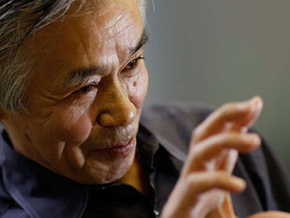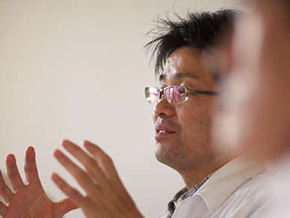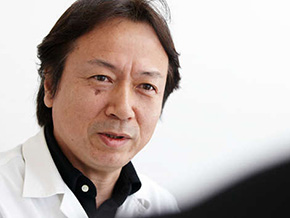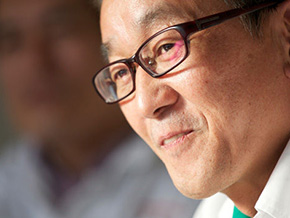Motorcycles Technology
CBR1000RR - History : Episode03
Still shining bright―the origins of the CBR series
Still shining bright—the origins of the CBR series
To create the most lightweight, compact bike in its class, one capable of beating the RVF750 racing motorcycle in the Suzuka 8 Hours Endurance Road Race… Born of this aspiration, the CBR continues to evolve today. The fundamental concept of total control remains the same, although the methods of attaining it vary with each CBR model. And Honda’s desire for each customer to enjoy total control at the highest level is another thing that will never change. Breaking with the highly aggressive super sport bike styling that was trendy at the time, the ninth-generation CBR1000RR instead took inspiration from the concentrated form of the original CBR900RR. An ambitious model that sought to realize total control using the same methods as the first-generation model, the ninth-generation CBR1000RR featured the latest technologies while respecting the origins of the CBR series.

Ninth-generation 2008 CBR1000RR

Once again the most lightweight and compact in its class
Former Honda Racing Corporation (HRC) works rider Hikaru Miyagi: The spec sheets show that the curb weight of the 2004 CBR1000RR is 208 kg, whereas the figure for the 2008 model is 199 kg. That’s quite a bit lighter.
Seventh-generation CBR1000RR Large Project Leader (LPL) Hirofumi Fukunaga: On the seventh-generation 2004 model, we implemented everything we could think of and left nothing out. This was the first time that we were designing a bike that would mainly be used on the street yet also in racing, so we had to cover both of those aspects completely. We therefore designed each element of the bike so that it would be more than good enough for racing. It’s not as though we had any regrets about this approach, but for the 2006 model we were able to use all of the information we’d gathered about its predecessor’s performance on the street and on the racetrack, which allowed us to slim down the new model considerably. Then, for the ninth-generation model, we used all of the new technologies we’d developed and once again aimed to create a bike that was the most lightweight and compact in its class. That was our approach.
Fifth-generation CBR900RR (CBR929RR) Assistant LPL Kenji Hasegawa: Using the latest technologies, once again we wanted to pursue the concept of a bike that’s the most lightweight and compact in its class and can beat the RVF750 in the Suzuka 8 Hours Endurance Road Race. Even though we were certain that our current CBR1000RR was better than any other bike at offering riders the joy of total control, we wanted one more time to question the correctness of our approach, reassess everything from the beginning and challenge ourselves to create the most lightweight and compact motorcycle possible. It was a development project in which we returned to the point of origin, not only in terms of concept but also in terms of method.
A pure expression of lightweight, compact design with concentrated mass
Since the mechanical parts of a bike flow seamlessly into the exterior, performance and design are indivisible elements. And new horizons in styling are naturally expected of hardware that leverages the latest technologies to achieve a maximally lightweight and compact design.
Miyagi: The 2008 CBR1000RR was a return to the point of origin, and its styling deviates somewhat from that of the models of the four preceding years. It calls to mind the first-generation CBR900RR, doesn’t it? I suppose this is another way in which it returned to the point of origin.
Ninth-generation CBR1000RR designer Toshiaki Kishi: Absolutely. The standard approach to super sport bike styling at the time was to make the bike as edgy, sharp and threatening in appearance as possible. It really felt as though every company was doing the same thing. But when we began developing the 2008 CBR1000RR, we doubted that following this trend would be the best way to appeal to potential customers.

Miyagi: All of the super sport bikes of the time gave off a vibe of having just returned from the circuit, didn’t they? Instead of regular riding wear, a racing suit looked better on someone who was riding one of them.
Kishi: That’s why, instead of simply following the trend and competing based on sharpness of design, we decided to emphasize the essence of the CBR series, which comes down to its fundamental functions and its lightweight, compact design with concentrated mass—and we wanted to give this concept a pure and formal expression to create an original design and new value. At the same time, we were implementing the latest technologies from racing and going for a new type of expression through the design.
Miyagi: You said the same thing in regard to the 2000 model, but for the 2008 model, you really went for styling that was close to the original CBR900RR. I liked the sharp feel of the 2004 model, but I also liked the design of the first-generation model. It was a little rounder and cuter.
Kishi: Right. Instead of going for stylishness, we created a warmer, more approachable and more emotional design. I thought of that hard, compressed shape as being like a fist. It’s design in the Honda tradition that goes back all the way to the Dream CB750 FOUR. For the 2008 CBR1000RR, we aimed to create a design in the Honda tradition that was respectful of functionality, and we crafted every part based on this principle. As a result, we designed the cowl, which has been hallmark of the bike’s styling, so that the outlets matched up perfectly with the lines of the radiator, enhancing ventilation efficiency and making the cowl more compact at the same time. From the start, in order to make the handling lighter, the engineers had wanted to concentrate the heavy parts in the center of the bike. We said we’d pull the front of the bike in as far as we could, and we asked them to take care of the coefficient of drag and handling. This was one part of the challenge of expressing functionality in a pure way.
Hasegawa: I think we asked them to pull things in the center as much as possible, but when we looked at the design sketches, there were some things in there that made us say, “Hmm, I think this is going a little too far.” [Laughs.]
Kishi: We researched the ancestor of Honda super sport bikes, the CB92, as well as its styling, which was nicknamed “shrine and temple.” Inspired by this, for the 2008 CBR1000RR we chose the traditional combination of black and vermillion that is used in many Shinto shrines and Buddhist temples in Japan. Being able to reflect the origins of the CBR series, Honda and Japan in the final form was a valuable experience for the future.

One step closer to achieving unmatched safety among super sport bikes
Unlike an automobile, a motorcycle has two brake systems that are independently controlled: one for the front wheel, and one for the rear. The reason is that a rider uses the brakes not only for stopping but also for overall control of the motorcycle. Expert riders can use skillful distribution of front and rear braking force to control the attitude of the bike and stop in the shortest distance possible without locking the wheels. Since differences in riding technique can produce widely varying results, Honda wondered how it could design CBR series bikes to assist riders in the area of braking. Leveraging many years of experience, Honda overcame a number of challenges to bring advanced braking assistance to its super sport models.
Former Honda Racing Corporation (HRC) works rider Hikaru Miyagi: In terms of function, design and every other area, the CBR1000RR returned to its origins, but there was also something new that brought it even closer to the ideal of a bike that anyone could enjoy riding. On the 2009 model you offered Electronically Controlled Combined ABS. Thanks to this feature, I really felt that this was now the super sport model that let riders enjoy a level of safety unmatched anywhere!
Fifth-generation CBR900RR (CBR929RR) Assistant LPL Kenji Hasegawa: Thank you very much. All of us have strong feelings about this topic. If you get me started, I could talk about it for one or two hours. [Laughs.]

Tenth-generation 2009 CBR1000RR
Fifth-generation CBR900RR (CBR929RR) body design team member Toshihisa Nagashii: At first everyone thought that, since adding Electronically Controlled Combined ABS would make the bike heavier than the standard specification, it couldn’t make riding better. I myself was on the fence about it. But when I got on a test bike to try it out, I thought the natural feel of how it operated was amazing.
Miyagi: When riding on the circuit, it lets you brake as heavily as you like without locking up the wheels, so ordinary riders won’t break into a cold sweat any more when they’re flying into the turns. What’s more, the system still supports the finely tuned front-rear distribution of braking force that’s so necessary in competitive riding on the circuit. It was as if a feature one would expect on a ¥10 million sports car was suddenly available on a regular ¥1 million car—I was just that surprised.
Final assembly team leader Kyoichi Yoshii: I asked [former MotoGP rider and Honda R&D Co., Ltd. research associate] Tohru Ukawa to try out the test vehicle and asked him what he thought after he got back after his lap around the track. He said, “I don’t really need it, but this would be really valuable for a regular rider.” But then I was looking at the test data from his run, smiling and thinking, “Ah hah!” He looked at me and said, “Oh, so I ended up using the antilock braking function?”

Miyagi: I see. That’s a great story! [Laughs.] It feels so natural when operating that even a MotoGP rider doesn’t notice!
Yoshii: We didn’t just throw this new function onto the bike, however. In other models, the ABS unit had gone near the suspension, but for the CBR1000RR we took pains to put it in the center of the bike to hold down unsprung weight and preserve the vehicle dynamics that are essential to super sport bike performance. Thus, the system can operate without distracting even a MotoGP rider, which for us engineers was the best result possible. It was really great that we undertook this initiative. After then-president Takeo Fukui announced that we would offer ABS on super sport models, we had to overcome many difficulties, but in the end I was glad that we could offer something that increases our customers’ enjoyment.
Miyagi: I think it would be good to use the system in racing, too.
Yoshii: Riders are definitely using it when regulations allow it. In 2010, we were participating in the German Superbike Championship, and before you know it we were vying for first place and ended up winning it all. And we’ve also achieved some excellent results with the system in the Endurance FIM World Championship.
Miyagi: Why don’t you promote these things more to the public? Honda is really bad at doing that! [Laughs.]
Yoshii: I think you’re right. [Laughs.] Promoting the use of the system in motor sports is important. But among all the ways in which a rider controls a bike, braking is one of the areas where variations in technique generate the biggest gap in performance. We created a system that allows the bike to support the rider in this area, allowing even more people to enjoy riding a super sport bike. And that’s the other way I feel we returned to the point of origin with the 2009 model.
CBR1000RR - History

Episode 00 : Challenging the supremacy of engine power

Episode 01 : Lightweight design that transcends the spec sheet

Episode 02 : Racing technologies prove their value on the street

Episode 03 : Still shining bright―the origins of the CBR series

Episode 04 : Beyond ease of handling lies the joy of control